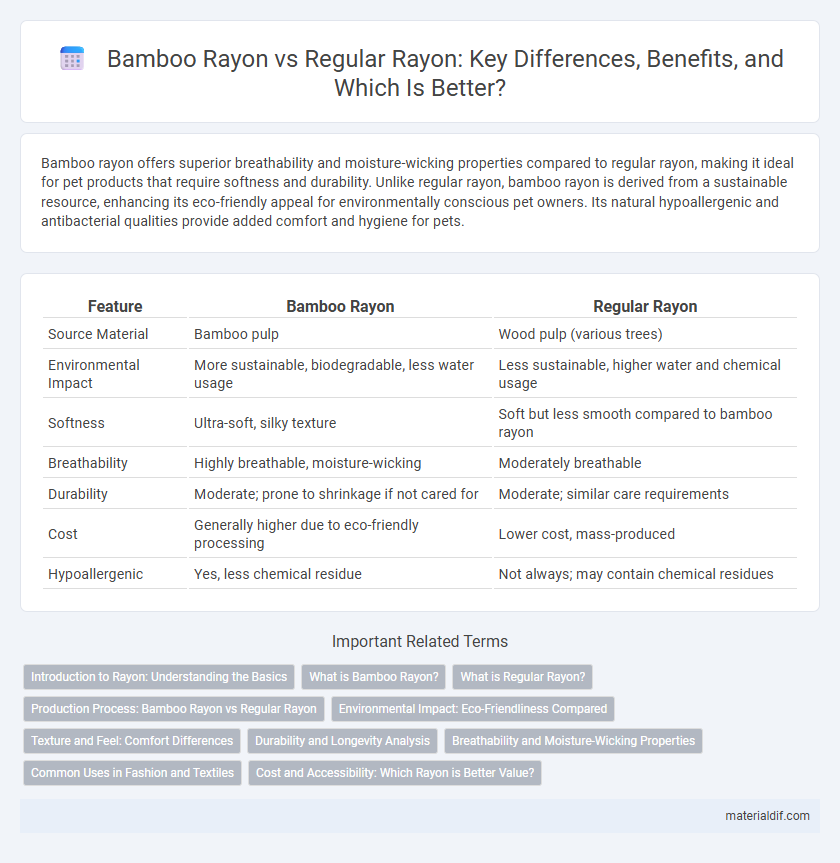Bamboo rayon offers superior breathability and moisture-wicking properties compared to regular rayon, making it ideal for pet products that require softness and durability. Unlike regular rayon, bamboo rayon is derived from a sustainable resource, enhancing its eco-friendly appeal for environmentally conscious pet owners. Its natural hypoallergenic and antibacterial qualities provide added comfort and hygiene for pets.
Table of Comparison
| Feature | Bamboo Rayon | Regular Rayon |
|---|---|---|
| Source Material | Bamboo pulp | Wood pulp (various trees) |
| Environmental Impact | More sustainable, biodegradable, less water usage | Less sustainable, higher water and chemical usage |
| Softness | Ultra-soft, silky texture | Soft but less smooth compared to bamboo rayon |
| Breathability | Highly breathable, moisture-wicking | Moderately breathable |
| Durability | Moderate; prone to shrinkage if not cared for | Moderate; similar care requirements |
| Cost | Generally higher due to eco-friendly processing | Lower cost, mass-produced |
| Hypoallergenic | Yes, less chemical residue | Not always; may contain chemical residues |
Introduction to Rayon: Understanding the Basics
Rayon is a versatile semi-synthetic fiber made from regenerated cellulose, offering breathability and a silk-like feel. Bamboo rayon, derived specifically from bamboo cellulose, boasts enhanced sustainability due to bamboo's rapid growth and natural antibacterial properties. Regular rayon, sourced from various wood pulps, provides similar softness and drape but lacks the eco-friendly benefits unique to bamboo-based fibers.
What is Bamboo Rayon?
Bamboo rayon, a type of rayon fiber derived from bamboo pulp, offers a sustainable alternative to traditional rayon made from wood pulp. The production process involves chemically treating bamboo to extract cellulose, resulting in a soft, breathable fabric with natural antibacterial properties. Bamboo rayon is valued for its eco-friendly credentials and moisture-wicking capabilities compared to conventional rayon.
What is Regular Rayon?
Regular rayon, also known as viscose rayon, is a semi-synthetic fiber made from regenerated cellulose derived primarily from wood pulp, often sourced from trees like beech, pine, and eucalyptus. It undergoes a chemical process involving carbon disulfide and sodium hydroxide to transform the cellulose into a soluble compound, which is then spun into fibers. This versatile fabric mimics the feel and texture of natural fibers such as cotton and silk, making it popular in textiles for clothing, upholstery, and industrial products.
Production Process: Bamboo Rayon vs Regular Rayon
Bamboo rayon production begins with extracting cellulose from bamboo fibers, which undergoes chemical treatment to transform it into viscose, similar to regular rayon derived primarily from wood pulp. The bamboo rayon process often emphasizes sustainable sourcing of raw materials, but both use chemically intensive methods involving carbon disulfide and sodium hydroxide to regenerate fibers. Differences in raw material origin impact environmental considerations, while the core viscose production mechanisms remain largely consistent between bamboo and regular rayon.
Environmental Impact: Eco-Friendliness Compared
Bamboo rayon is often considered more eco-friendly than regular rayon due to bamboo's rapid growth and minimal need for pesticides or fertilizers, which reduces soil degradation and chemical runoff. However, the production process for both involves chemical-intensive treatments that can harm the environment if not properly managed. Sustainable sourcing and closed-loop manufacturing systems are critical in minimizing the ecological footprint of both bamboo and regular rayon fibers.
Texture and Feel: Comfort Differences
Bamboo rayon offers a softer and more breathable texture compared to regular rayon, providing enhanced comfort for sensitive skin. Its natural moisture-wicking properties help maintain dryness, making it ideal for warm climates or active wear. Regular rayon, while smooth, often feels less airy and can retain moisture, reducing overall comfort.
Durability and Longevity Analysis
Bamboo rayon exhibits enhanced durability compared to regular rayon due to its natural antimicrobial properties and higher tensile strength, which contribute to longer fabric life and resistance to wear and tear. The cellulose fibers extracted from bamboo retain a stronger molecular structure, resulting in improved fabric resilience under repetitive use and washing cycles. In contrast, regular rayon, derived primarily from wood pulp, tends to weaken and degrade faster, reducing its overall longevity and performance in demanding applications.
Breathability and Moisture-Wicking Properties
Bamboo rayon offers superior breathability compared to regular rayon due to its natural micro-gaps that enhance air circulation, keeping the fabric cooler and more comfortable. It also excels in moisture-wicking properties, effectively drawing sweat away from the skin to maintain dryness and reduce odor buildup. Regular rayon, while breathable, lacks the enhanced moisture management and cooling effects inherent to bamboo-derived fibers.
Common Uses in Fashion and Textiles
Bamboo rayon is highly favored in fashion for its eco-friendly properties and superior softness, often used in making sustainable activewear, baby clothes, and breathable summer garments. Regular rayon, while versatile and cost-effective, is predominantly utilized in everyday apparel such as blouses, linings, and dresses due to its smooth texture and drape. Both fibers excel in textile production, but bamboo rayon's moisture-wicking and antibacterial qualities give it an edge in performance and comfort-focused clothing lines.
Cost and Accessibility: Which Rayon is Better Value?
Bamboo rayon generally costs more than regular rayon due to its eco-friendly appeal and sustainable sourcing, but it offers better value for consumers prioritizing environmental impact. Regular rayon is more widely available and cheaper, making it a practical choice for budget-conscious consumers seeking versatile fabric. Evaluating cost against accessibility and eco-friendliness helps determine the most suitable rayon for individual needs.
Bamboo Rayon vs Regular Rayon Infographic

 materialdif.com
materialdif.com